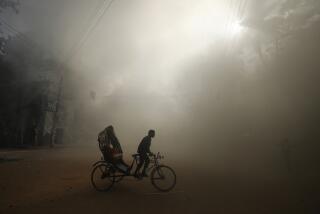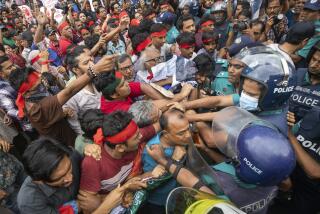Bangladesh Tornado Leaves 443 Dead
- Share via
DHAKA, Bangladesh — Despite this nation’s long and deadly history of natural disasters, nobody was prepared for a tornado that raced through at 125 mph, killing at least 443 people and injuring more than 32,000.
Tearing tin roofs to shreds and turning tree branches into deadly missiles, Monday’s twister flattened 80 villages, blew away more than 10,000 mostly mud-and-straw huts and buried dozens of people alive in a 20-minute burst of destruction.
As the extent of the disaster unfolded Tuesday, survivors accused the government of failing to provide emergency assistance and local hospitals of turning away victims.
The tornado struck hardest in the Tangail district, 45 miles north of Dhaka, the capital of Bangladesh.
At least 120 of the dead were from Bashail, a village where the victims included students in a boarding school building that collapsed on top of them, said Irsat Jahan, the local administrator.
Jahan, who released the official toll of dead and injured, said many more bodies will probably be found when government relief workers reach the site today. State TV said Tuesday night that the death toll had reached 443.
In the village of Rampur, a 45-year-old weaver, Reazuddin Ahmed, said: “When the killer storm came, I saw the tin roofs of homes cut into pieces and flying everywhere.”
Ahmed said that as the sky darkened and the winds began to howl, he gathered his wife and three children near a concrete wall alongside a road near their home and prayed to be spared.
There they watched the tornado toss the village’s wooden houses into the air and reduce several larger buildings, including a movie house, to rubble.
“It looked like hell had been let loose. It was dust and wind everywhere. We prayed to God: ‘Save us,’ ” said Babul Ahmed, Reazuddin’s 10-year-old son.
The Ahmeds survived, but at least 55 of their neighbors died. On Tuesday, their bodies were retrieved and lined up for burial in a soccer field near a collapsed school building.
Many of the survivors were left alone to search for the bodies of their relatives and to prepare for their burial.
State radio initially estimated the death toll at 22--apparently one reason for the government’s failure to immediately send relief workers and supplies.
Another was the scope of destruction, compounded by downed communication lines in this densely populated, impoverished country of 128 million people.
The tornado snapped telephone lines and uprooted many trees between Tangail and Dhaka, making it difficult for anyone to reach most of the affected area for hours.
*
The tragedy quickly overwhelmed local hospitals as thousands of injured people arrived for treatment, many of them bleeding from cuts all over their bodies.
At a government hospital in Tangail, Mohammed Arif, a 10-year-old boy, was writhing on a floor alongside six bodies wrapped in bedspreads.
The 200-bed hospital was flooded with more than 1,000 injured people lying on its floors.
A nurse treating Arif said the hospital quickly ran out of bandages, medicine and surgical equipment. Speaking on condition of anonymity, she said at least 50 people died shortly after arrival.
Altaf Hossain, who runs a medical store in the town of Tangail, said he saw the hospital authorities turn away four pickup trucks, some filled with bodies, some with injured people.
More to Read
Sign up for Essential California
The most important California stories and recommendations in your inbox every morning.
You may occasionally receive promotional content from the Los Angeles Times.













